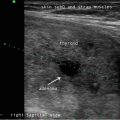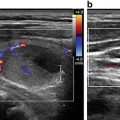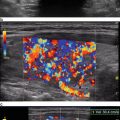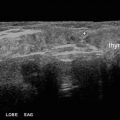Author
Pts/Nodules
RCT
US pattern
Baseline Vol
Laser source
Energy load
Number of sessions (mean)
FU month
Volume reduction
no.
solid-cystica
mL (mean)
Joules/mL (mean)
% (mean)
Dossing et al.
16
solid
10.0
820 diode
761 (median)
1
6
46
Spiezia et al.
5
solid
11.1
Nd:YAG
2.2
12
61
Pacella et al.
8
solid
22.7
Nd:YAG
788
4.1
6
63
Papini et al.
20
solid
24.1
Nd:YAG
300
2.2
6
64
Dossing et al.
15 vs 15
yes
solid
8.2
820 diode
224 (median)
1
6
44 (median)
Dossing et al.
10
cystic-solid
9.6
820 diode
254 (median)
1
12
57
Amabile et al.
23
solid
15.0
980 diode
33
1.2
3
36
Dossing et al.
15 vs 15b
yes
solid
10.1/10.7
820 diode
262 vs 412
1
6
45 vs 58 (median)
Gambelunghe et al.
13 vs 13
yes
solid
8.2
Nd:YAG
1900 (median)
1
30 weeks
44
Cakir et al.
12/15
solid
11.9
810 diode
2726
1.5
12
82
Papini et al.
21 vs 21 vs 20c
yes
solid
11.7/13.6/12.1
Nd:YAG
1221
1
12
>40
Valcavi et al.
119
solid
24.8
Nd:YAG
1
12
56
Valcavi et al.
122d
solid
23.1
Nd:YAG
484 (median)
1
36
48
Dossing et al.
78
yes
solid
8.2
820 diode
242 (median)
1
67
51 (median)
Amabile et al.
51e
solid
53.5
980 diode
391
3.2 cycle
12
81
Gambelunghe et al.
20/20f
solid
15/14
Nd:YAG
71/579 (median)
1
36
+11/57
Gambelunghe et al.
50/50l
solid
21/21
Nd:YAG
502/499
1
6
55/56 (median)
Papini et al.
101/99
yes
solid
12
Nd:YAG
__
1
36
57
Achille et al.
45
solid
24
Nd:YAG
__
1
12
84
Pacella et al.
1531/1534
solid
27
Nd:YAG
__
1.2
12
72
Finally, in 2015, an externally monitored multicenter retrospective study of 1531 patients confirmed both the efficacy and the safety in clinical practice of the multiple thin needle ablation technique [2, 3] for the nonsurgical management of benign symptomatic thyroid nodules. Because this population included those who both received multiple treatments for large nodules and had complex lesions, the results demonstrated an up to 80 % decrease of thyroid nodules.
The histopathologic changes on the basis of nodule shrinkage in humans are the same as in experimental models [4]. Cytological and histological samples obtained in 15 cold thyroid nodules 12 months after multiple LA procedures demonstrated coagulative necrosis, degenerative changes, and signs of inflammatory reaction in the ablated areas [73]. No malignant change has been reported even in nodules resected 24 months after laser ablation [53].
37.7.2 Hyper-Functioning Thyroid Nodules
Reports evaluating the efficacy of LA for therapy of hyperthyroidism due to hyperfunctioning nodules have less consistent results. A few small series of hyper-functioning thyroid nodules treated with laser ablation report normalization of thyroid function and the resolution of the previously hyperfunctioning area at post-treatment radioisotope scan [50, 55, 60]. Others demonstrated that LA was not invariably effective, and that multiple LA sessions were required to normalize TSH levels [48, 61, 74]. Finally, a randomized trial on 30 solitary hot nodules with extraglandular suppression, treated either with a single LA session or one radioiodine dose, demonstrated that LA and 131I therapy had a similar effect on nodule volume reduction. However in contrast to 131I, LA was less likely to results in a normal serum TSH (only 50 % of patients) [75]. Overall, these results demonstrate the effectiveness of LA when treating small, solitary and mildly hyperfunctioning nodules [65, 74]. In toxic nodular goiters or large autonomously functioning thyroid nodules, LA therapy results are more inconsistent and the normalization of thyroid function usually requires repeated treatment sessions [48] (Table 37.2). A recent pilot study [76] compared outcomes in patients large toxic nodules treated with LA followed by 131I with those treated by 131I only, and demonstrated that combined treatment induced a more rapid and substantial improvement in local and systemic symptoms compared to 131I only. In addition, for three patients, no 131I treatment was needed after LA. This approach seems a possible alternative to thyroidectomy in patients who refuse surgery.
Table 37.2
Clinical outcomes of patients with symptomatic benign hot thyroid nodules treated with laser ablation (major series)
Author | Nodules | RCT | US pattern | Baseline Vol | Laser source | Total Energy load or | Number of sessions | FU | Volume Reduction | TSH changes | Hormones changes |
|---|---|---|---|---|---|---|---|---|---|---|---|
No. | mL (mean) | Joules/mL (mean) | (mean) | moth | % (mean) | (%)* | (%)* | ||||
Dossing et al. | 1 | solid | 8.2 | 820 diode | 1950 | 1 | 9 | 40 | Na | Na | |
Spiezia et al. | 7 | solid | 3.2 | Nd:YAG | 1 | 12 | 74 | Nb | 7/7 (100) | ||
Pacella et al. | 16 | solid | 7.9 | Nd:YAG | 816 (J/mL) | 2.7 | 6 | 62 | 5/16 (31) 5/16 (31) | ||
Gambelunghe et al. | 13 | solid | 8.2 | Nd:YAG | 1900 (J/mL) | 1 | 30 weeks | 44 | 13/13 (100) | 13/13 (100) | |
Barbaro et al. | 18 | solid | 21.1 | Nd:YAG | 3 | 12 | 59 | Nc | |||
Dossing et al. | 14 vs 15 | yes** | solid | 10.6/11.2 | 820 diode | 217 (J/mL) | 1 | 6 | 44/47 | 7/14–15/15 (50–100) | |
Valcavi et al. | 1 | solid | 2.5 | Nd:YAG | 1 | __ | 95 | Nd | Nd | ||
Rotondi et al. | 1 | solid | 55.0 | 980 diode | 4 | 10 | 91 | Ne | Ne | ||
Amabile et al. | 26 | solid | 55.3 | 980 diode | 379 (J/mL) | 3.2 cycle | 12 | 82 | 23/26 (88) | __ |
37.7.3 Cystic Lesions
In a recent report, 44 subjects with predominantly cystic thyroid nodules were randomly assigned to aspiration alone or to fluid drainage immediately followed by laser ablation [59]. At 6 month follow-up, both clinically significant volume decrease and improvement of local symptoms were observed in 15 of 22 (68 %) of cases in the thermal ablation group compared to only 4 of 22 (18 %) cases in the fluid drainage group. Laser ablation significant decreased the solid component of the cystic lesion (from 1.8 to 1.0 mL), while in the drainage alone group, the solid part was not reduced. No side effects were reported and thyroid function was maintained.
Even if the outcomes of laser ablation for cystic nodules are favorable, percutaneous ethanol injection still remains the first-line minimally invasive treatment for predominantly cystic lesions due to its low cost, safety, and easiness [77]. Laser ablation should be considered only for the management of complex lesions with a relevant solid component because it will both prevent fluid recurrence and reduce of the solid part of the nodule.
37.8 Complications and Side Effects
Laser ablation is a fairly well tolerated procedure. Mild to moderate cervical pain, minor neck swelling and a low-grade fever may occur after treatment and commonly last 1 or 2 days. These side effects may be controlled with the oral administration of acetaminophen.
Minor complications are infrequent and include persistent cervical pain that radiates to the ear, lower jaw or chest that does not dissipate after the laser ablation procedure. Pain subsides spontaneously but may last up to 24 h is done [61, 62]. Subcapsular hematoma and skin burns are extremely rare [52, 69]. Severe neck swelling due to subcutaneous edema, and cystic transformation have been occasionally reported [66]. The occurrence of transitory hyperthyroidism or late hypothyroidism is rare in patients with normal thyroid function [66].
Stay updated, free articles. Join our Telegram channel

Full access? Get Clinical Tree








